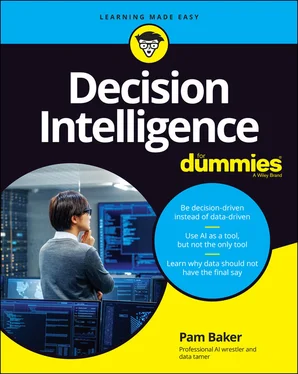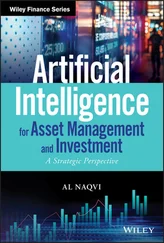1 ...7 8 9 11 12 13 ...17
Embracing the new, not-so-new idea
The term decision intelligence has been in use for at least the past 20 to 25 years — one of its earliest mentions is in the scholarly paper “Knowledge Management + Business Intelligence = Decision Intelligence,” by Uwe Hannig, a German academic specializing in information and performance management. The meaning of the term decision intelligence continues to change somewhat as vendors try to fit the term to their own products or purposes. Meta S. Brown, the author of Data Mining For Dummies (Wiley) and president of A4A Brown Inc., a consultancy specializing in guidance for launching and expanding analytics projects, says of decision intelligence that “solution vendors associate it with enterprise software, for example, though practitioners not tied to products see it as a broad set of disciplines brought together for decision making.”
It’s still very much a buyer-beware field, in other words. Products will be marketed as decision intelligence tools that aren’t — or perhaps are but are also good for other purposes. Just as a clawhammer can be sold as a house-building tool and a nail-puller, so, too, can many techniques, tactics and tools be used for decision intelligence as well as for other analytical tasks.
Good analytics practice in general, regardless of labeling such as AI, data science, and data mining, are found in an existing open standard for data mining process called CRISP-DM. (Check out Data Mining For Dummies if you’re curious about this standard.)
Many of the details in CRISP-DM are used by data analysts, business managers, IT leaders and others in a variety of business roles. Decision Intelligence extends on that idea.
But the distinction between the two concepts — data mining and decision intelligence — is perhaps best understood in their respective outputs:
Data science tells you what is knowable in any given universe of information. It can do so by answering your questions (data queries) or by automating pattern detection (advanced analytics or AI).
Decision intelligence, by comparison, integrates what’s known into a decision process. It’s the difference between knowing how COVID-19 spreads (data science) and using that and other information in a structured process to decide whether to allow people to return to work (decision intelligence).
 Impact is ultimately the answer everyone seeks. When every business and life question essentially boils down to the question of what you should do to achieve this impact, it makes sense to start the decision-making process with the impact you seek and the answer you most need.
Impact is ultimately the answer everyone seeks. When every business and life question essentially boils down to the question of what you should do to achieve this impact, it makes sense to start the decision-making process with the impact you seek and the answer you most need.
Avoiding thought boxes and data query borders
Traditional data mining tends to box in your thinking and put borders around the questions you ask by simply focusing the work on the data in question.
For example, if you’re mining marketing and sales data for insights, your thinking predictably shifts to a more or less standardized list of questions. That’s natural because it’s how humans organize information as well as their thinking about information.
In other words, people label data to organize it, but those same labels also influence how they think about the information so labeled. It’s weird how that works, isn’t it?
Nonetheless, labels are helpful to a large degree, and you can hardly function in using data without them. They’re so helpful that Google’s head of decision intelligence said that if data scientists and statisticians were left to their own devices, they would have named machine learning “the labeling of things” because these professionals prefer names that label what the thing actually does.
If you feel that this discussion is going in circles now, you’re right. And that’s the best illustration I can think to offer you on how traditional data mining limits everyone’s thinking and querying.
Care to go around again? No? Well, people do continue to repeat many of their efforts in analyzing data anyway. Most often folks do that by refreshing the data and repeating the query — over and over again.
Models, algorithms, and queries are shaped accordingly. Machine learning, also known as AI in common use, is trained on this or similar data where it learns the most often asked questions and the common outputs. Querying is often automated, which results in a list of preselected questions. Even drill-downs in data represented by interactive visualizations are preset.
Those parameters form the box analytics software users find themselves in, the bordering that places restraints on querying, and the reasoning behind the repetitions in actions.
DATA ANALYSIS RUTS AND ROAMS
Traditional data mining processes usually look something like this:
1 Prep data from existing sources — such as systems used for routine business operations, streaming data, or data centers — for use in analytics.
2 Mine the data with a variety of tools, including analytics and machine learning (known commonly as AI).
3 Visualize the outputs — make graphic representations of the insights gleaned from analyzing the data, in other words.
4 Decide what action to take based on these insights.
5 Refresh the data and then rinse and repeat.
Unfortunately, data miners and data scientists often hand over the results of their hard work only to find that nothing came of it because there was no realistic business plan to use them in the first place. By comparison, decision intelligence ensures a plan is in place from the outset.
Still, there’s no reason to throw out the traditional data mining process when you make your move to decision intelligence. Indeed, you’d be nuts to do that. This process works quite beautifully in many use cases — most notably, those that are unmuddied by nuance, gray areas, and language confusions. For example, is the color yellow meant to signify Caution or Coward in any given data set? That may depend on one of those gray areas, which, in this particular case, is bound up in context. Data scientists are quite familiar with these issues and deal with them every day.
More defined questions are arguably better suited to how analytics are positioned in this process. For example, it’s true that predictive analytics will be correct more often than humans in determining the last day of usefulness of a machine part. It’s also true that analytics will be accurate more often than people — even experts — in detecting patterns in massive amounts of data.
But it’s also important to understand the limitations of this approach. Machines can do only so much. They don’t think or learn as you and I do. For example, machine learning can sort data faster than humans in any this-is-a-cat-this-is-not choice of well-defined options. But even then, machines are likely to mislabel a few cat pictures that a human child would instantly recognize to be distinctly feline.
By comparison, decision intelligence melds your mind to the machine’s “mind” so that the strengths of each one overcome the other’s weakness. Obviously, it’s not an actual melding of human and machine, but rather a blend of decision capabilities.
That’s a vital advance because it renders outputs of greater significance to problem solving and additional analysis of real world impacts. An unintended side effect of using the traditional model was the devaluation of the worth of human input outside of programming and other software development activities. We humans got into the habit of putting total faith in algorithm outputs — even when the outputs are in conflict with our thoughts and experiences. We do this despite it being well known that data is rarely perfect or complete. But that’s not the only problem challenging our blind faith in data analysis.
Читать дальше

 Impact is ultimately the answer everyone seeks. When every business and life question essentially boils down to the question of what you should do to achieve this impact, it makes sense to start the decision-making process with the impact you seek and the answer you most need.
Impact is ultimately the answer everyone seeks. When every business and life question essentially boils down to the question of what you should do to achieve this impact, it makes sense to start the decision-making process with the impact you seek and the answer you most need.










